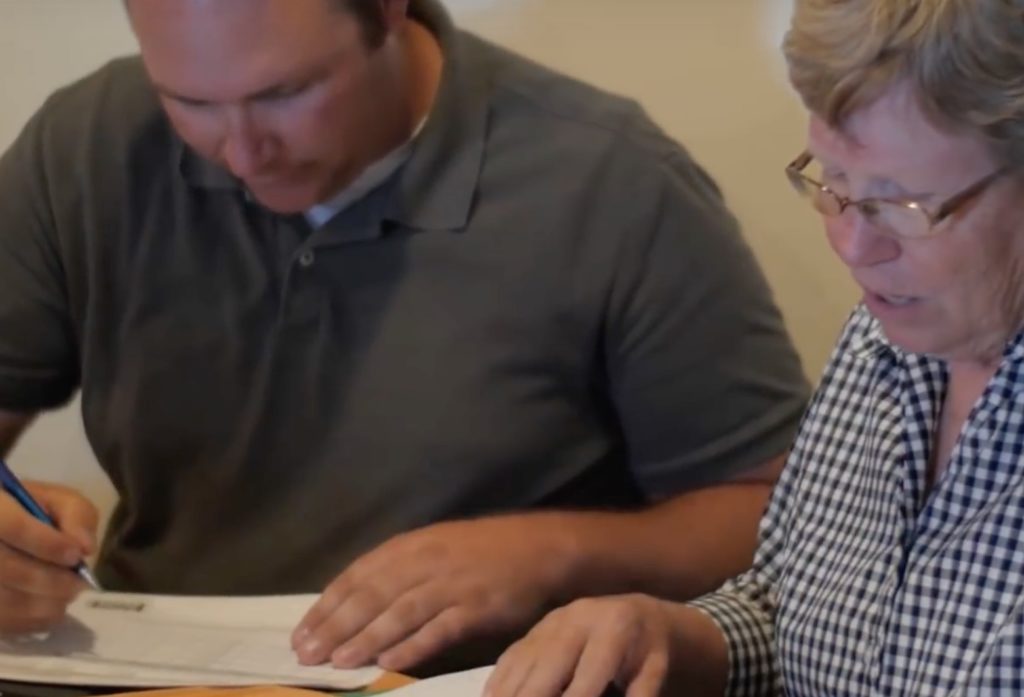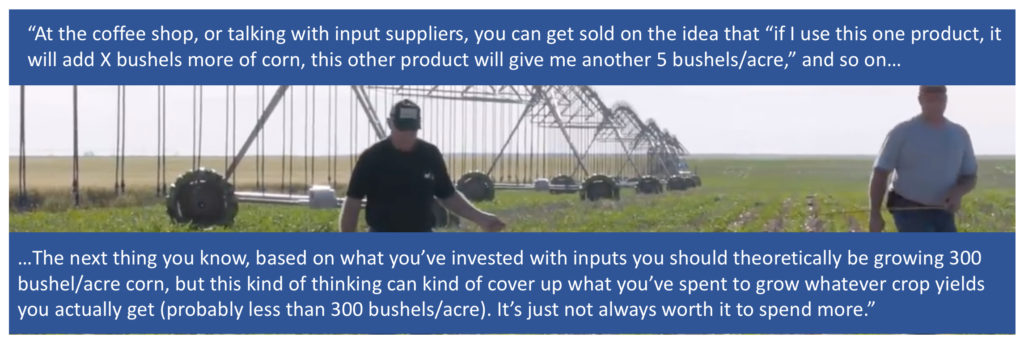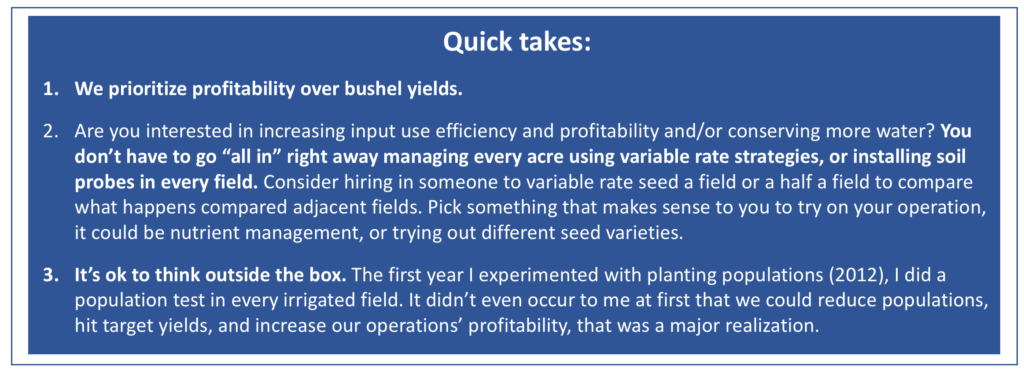
Gerald & Tim Franklin, producers
Tim and Gerald Franklin, Goodland, KS
Producers
Gerald and Tim Franklin, father and son farmers in Sherman County, were not only the first family in Kansas to enroll in a Water Conservation Area, but they were also one of the first farms to be involved with the Water Technology Farm at Northwest Kansas Technical College in Goodland. Along with their spouses, Linda and Katherine, they believe in saving water for the next generation.
About a quarter of their acres are irrigated, the other ~75% is in dryland crop production. They mostly grow corn on their irrigated land, sometimes rotating with wheat. They’ve experimented with other rotations and are looking into using cover crops. “Mainly we try to focus on a few things at a time and figure out how to do them well; we try to find ways to improve every year,” Tim Franklin says.
Motivation. When my wife and I moved back to the farm in 2011, my dad tasked us with figuring out how to transition the irrigated part of our operation over to dryland production. Our family was concerned about well decline and the possibility of different state level controls coming in (such as an IGUCA or other measure being put into effect by groundwater management districts a.k.a. GMDS) that might reduce allocations or cut off wells with lower priority permits.
Initially, when our family first started really talking about water, we were thinking along the lines of “leave us alone, we’re doing what we can and we are conserving in our own way; we’re doing what’s best for our own ground.” We were already doing some things to improve water conservation on our farm. We’d knocked off lower hanging fruit, setting up LEPA systems on all of our sprinklers, with drops 3-5 feet off the ground, for example. Going to some GMD meetings, though, we were struck when we heard someone say “let’s stop kicking the can down the road, we need to do something now” to meaningfully address aquifer declines in our area. That’s when we started looking seriously at Kansas’s Water Conservation Area (WCA) model, which my parents had heard about from the Farm Bureau and newspapers.
We had several conversations with Kansas Farm Bureau and with the Kansas Department of Agriculture (KDA) to learn what options and requirements we’d have with a WCA, and also to make sure we wouldn’t be hurting ourselves by creating one. We lobbed several proposals back and forth, all the while talking on our end about the potential upsides and downsides: was a WCA doable and did we think it would it help us, or not?
During one conversation with KDA, my dad said, “it’s hard to be against the conservation of water. When my kids and grandkids look back, I want them to know that we did what was right for their generation.” We decided to give the WCA a try for a year. We said to ourselves that if the rubber hits the road and it didn’t work that we could write a letter to the State to dissolve it.
We like the flexibility of our WCA, which lets us roll a portion of our annual allocation forward. Water we don’t need—such as when we got hailed several times this year, or during a wet year like 2017—gets saved for another dry year that we know is going to come, like 2012, when we’ll need those acre-inches of water to be successful growing some kind of crop. In the first three years of our WCA we’ve been able to “bank” a year’s worth of water.
Management methods. We don’t have the biggest well capacities on our farm, and it's possible people would say this is why we set up a Water Conservation Area. We’d say, though, that for us the WCA is actually more about our farm management. For example, we try to have our water turned off by the first of September to let winter precipitation recharge the soil profile, while some of our neighbors keep their pivots on to pre-water.
The same year we started our WCA we switched from strip till to no-till management to save water on our irrigated land. No-till poses some challenges in and of itself, especially with managing residue, in trying to raise profitable corn. We’ve made some equipment modifications on our planter to deal with crop residue and get better seed-soil contact for better stands. Compared to strip till, no-till management has some contingencies. With strip-till I could get out to the field whenever I wanted, day or night, and I could drive a bit faster. With no-till, the sun has to be out and the residue has to be dry or I become a big rake dragging residue around.
 We’d dabbled with using soil probes in the past but didn’t have as much success with them until we started working with consultant Cory Gilbert and his team from OnTarget Ag Solutions; they seem to understand our soils. We now have a probe in every irrigated field. Cory used Varus soil mapping to identify a spot representative of the average soil moisture holding capacity in each field so that we can extrapolate from there how the rest of the field is doing for moisture.
We’d dabbled with using soil probes in the past but didn’t have as much success with them until we started working with consultant Cory Gilbert and his team from OnTarget Ag Solutions; they seem to understand our soils. We now have a probe in every irrigated field. Cory used Varus soil mapping to identify a spot representative of the average soil moisture holding capacity in each field so that we can extrapolate from there how the rest of the field is doing for moisture.
You hear a lot of talk about whether soil probes are accurate or not, and how important that accuracy is for them to be valuable. Our farm definitely finds using soil probe data to be valuable. While the probes may not tell me if there’s 1.25 inches of water that my plant can take up in the top 18 inches of soil, I can tell using them what depth water is getting to, whether it’s from rainfall or irrigation. If I’m fertigating, using soil probes lets me know how much to run my pivot to keep the water within the top 10 to 24 inches of soil. They also give me an idea of how active plant roots are at different levels, which helps in more ways than one, in part because root structures of different varieties of corn can vary so much.
Having a soil probe in each of our irrigated circles has definitely saved us money. How we manage water on our farm using the probes and residue helps keeps nutrients in the root zone, preventing money we’ve spent on them from leaching or washing away. On average with dry and wet years, if you made me guess, the return on investment time for soil probes is three to five years. In a wet year, soil probes probably pay themselves with the money they save each time you decide you don’t need to go around with your pivots.
Over time, I expect that soil moisture probe technology will only improve. I don’t have an agronomy degree, and I can’t tell you every kind of soil I have in my fields, but the soil probe is a tool that helps me manage my water more effectively than I was doing before. Are they perfect? No, but the information they provide is a lot better than what we had before, which was less or no information.
"If we get an inch of rain, I feel much more comfortable and confident about how long I can leave pivots off. Before I’d be heading out with a shovel several times each growing season to soil sample and make decisions." -Tim Franklin
Mistakes. Once, in an earlier attempt to use soil probes, working with a different company than we do now, we had a probe that wasn’t working. The company we were working with hadn’t GPS-located any of the probes they’d put out. We didn’t want to hit it with the combine, and my mom and I ended up walking through the field to try to find it. I didn’t even think about that when I was checking it early in the season, but it’s another thing altogether to try and find a probe in eight-foot-tall corn. I was kicking myself because it would have been a simple fix just to go out there with my phone and drop a pin to mark where the probe was.
Money Matters. With our approach in planting low seed populations (20,000 to 28,000 seeds/ac), ultimately it comes down to profitability. You might be able to raise 300 bushel/ac corn, but is it profitable? We have found that the sweet spot of us is in the 200-220 bushels/ac range.
Seed companies don’t seem to do much low population testing of their varieties. Being able to trust and rely on local seed dealers who have worked to understand how varieties respond at lower populations is very important. Our discussions with OnTarget on potential yield led us to change varieties, positively impacting our profitability; that’s what we pay them to do.

Recently we’ve also gotten into using VR strategies on our dryland acres. Savings gained with VR on our irrigated acres paid to write the VR scripts for our dryland acres. With variable rate, we can optimize seed populations for areas with greater or lower soil water holding capacity. We gain some savings by not planting a flat rate as well as with VR fertigation of nutrients. Our goal on both our irrigated and dryland acres is to be efficient as possible and hit our yield targets, rather than shooting for high yields. My dad would like to add: "what is 5 inches of water worth to a dryland farmer? Then add the ability to time its application."
This year (2018) we got hailed badly several times. Rather than trying to raise 220 bushels/acre corn, we cut our water use back to meet the needs of the plants still out there, aiming for 160 bushels/acre yields instead of 220 bushels/acre. At the end of the season, had our crop insurance adjuster challenged us on the yields we posted, our soil moisture probe data protects us because it shows that we provided sufficient water to the crop that remained after the losses incurred through hail damage.
Mindset. Some people farm going by their gut, keeping track of what they spend and earn in their head. Our approach is different: we focus on maximizing profits by keeping track of and adjusting our seeding, watering and nutrients at the sub-field level to reach target yield goals. A seed dealer I was visiting with recently told me I was one of only three farmers he’d spoken with so far who is trying to do that.
Getting into using precision agriculture strategies to improve profitability doesn’t have to be a costly investment. A cheap hydraulic pump that runs using the GPS on your tractor costs $4,000-5,000. Most late model equipment these days comes with advanced technology options that people may not be using- yield monitors, variable rate seed or fertilizer capabilities.
With our WCA and shifts in how we manage, our farm’s water future looks more positive than it did before. The possibility of drying up our irrigated acres is still in the back of our minds, which partly drives why we’re figuring out VR strategies for our dryland acres. This year turned out to be an average moisture year; we know we can raise pretty good no-till dryland corn with advancements of VR scripts and how the corn varieties flex. Meanwhile, discussions on water in our area, partly from WCAs and our groundwater management district’s new district-wide Local Enhanced Management Area [insert link] is making us and our neighbors more aware than before of what we can do to conserve water. That’s a positive thing.
Tim Franklin was interviewed by Amy Kremen on November 18, 2018.
Back to 2021 Ogallala Aquifer Virtual Summit main page/agenda
View map/info for 2021 Ogallala Aquifer Virtual Summit speakers and participants
"Having a soil probe in each of our irrigated circles has definitely saved us money. How we manage water on our farm using the probes and residue helps keeps nutrients in the root zone, preventing money we’ve spent on them from leaching or washing away.
”
- Tim and Gerald Franklin



